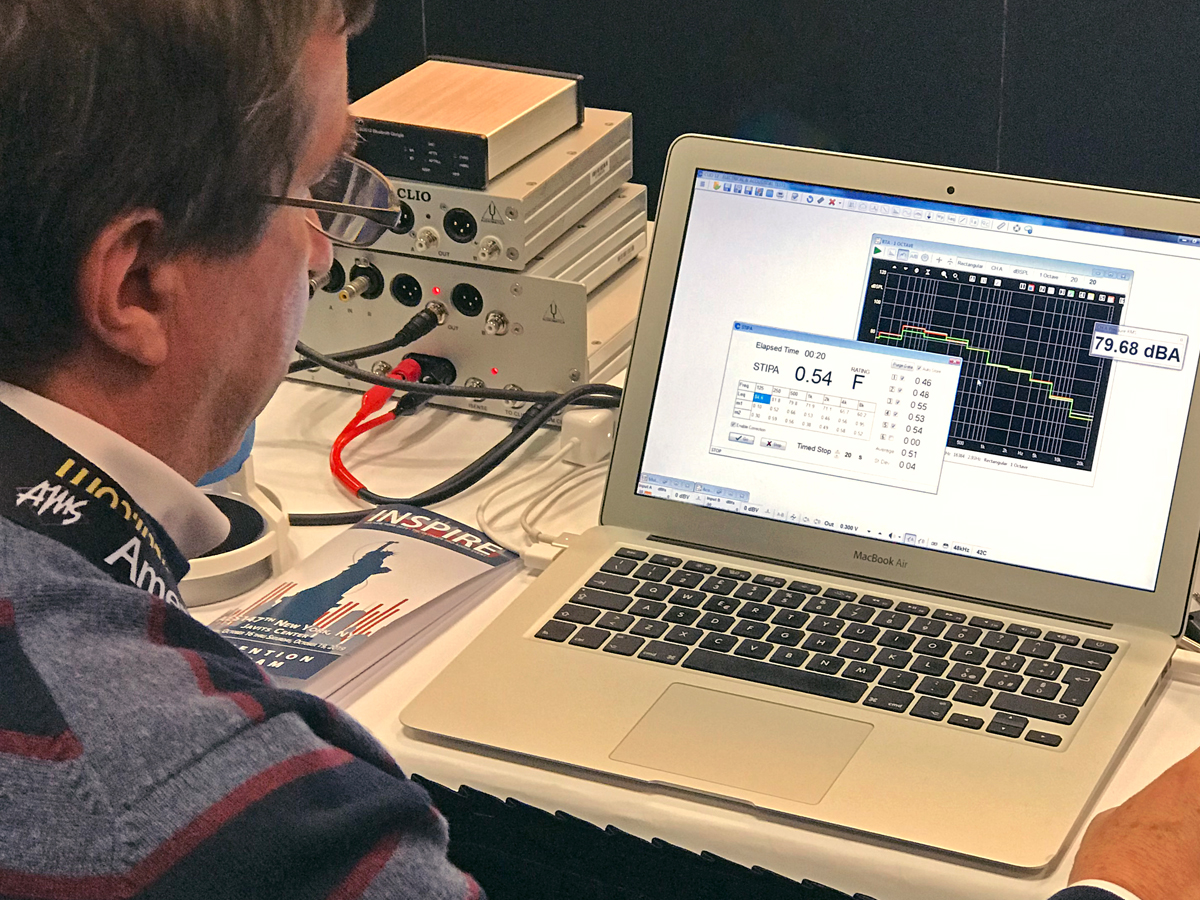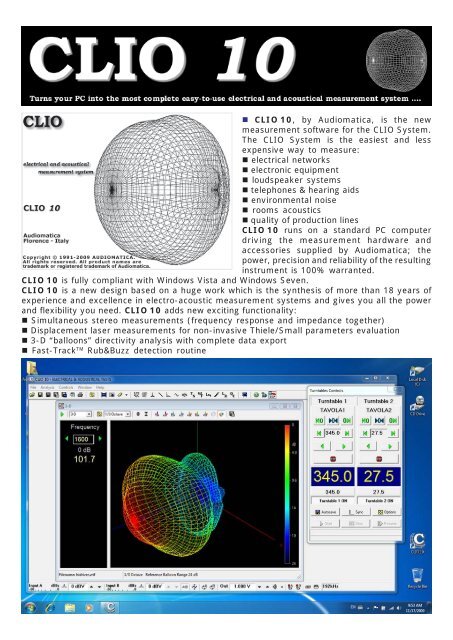Go to: CLIOGEARLspCADLitterature
(Audiomatica recently sent us an updated version of the CLIO Pocket software, which now includes a semi-circular polar plot for better front radiation analysis.) Figure 6 shows the two-sample SPL comparison, indicating the two samples were closely matched, with a small 0.25 dB variation between 1.5 to 6.5 kHz, with 0.5 to 1.5 dB variation. Audiomatica CLIO Pocket Version 2 Personal Acoustic Measurement SystemCLIO Pocket is Audiomatica's portable loudspeaker testing and measurement system. From measuring capacitors and calculating T/S parameters, to measuring the frequency response of a finished speaker, CLIO Pocket can do it all! The completely revamped software has a redesigned user interface that's optimized for touch screens. Www.audiomatica.com Haynes Publishing provide manuals for a wide range of Renault models. Learn how to make DIY car repairs and service your Renault with our comprehensive guides. Manuals - Renault View and Download Renault Clio workshop repair manual online. SRP AIR BAGS, PRETENSIONERS and SEAT BELTS.
I'm not sponsored by any company or individual here, but this is some of the gear and literature I have used for making loudspeakers. The materials shown here will set you back some 2,000 US $ minimum to get started. Besides this you need a milliohm meter to measure driver Re accurately. These don't come cheap, usually around 400 US $. Click links or images to go to websites.
CLIO 12 Measuring Equipment http://www.audiomatica.com/
There used to be a long story on my CLIO equipment dating back more than ten years. It hasn't always been easy but I guess if you start from scratch these days, life should easier. That is, if you can find a laptop with a firewire port or a laptop allowing an express card with firewire connection. Check out all this carefully before ordering the CLIO system! I find it problematic that Audiomatica display the image above as though you just plug your CLIO FW into a laptop. Some customer service in terms of suitable laptops the CLIO FW would be nice. And they might have told you most likely will need a 12 V DC adaptor to run the CLIO box. If your laptop doesn't have a firewire port, then what PC Cards are suitable, etc., because PC Cards comes in a wide range of variants and you have to learn about IEEE 1394a and IEEE 1394b, etc. For the non-computer nerds, this takes quite some time and this is an ever changing world where things may change rapidly and what you think is safe for the foreseeable future may be extinct tomorrow. If you want to be on the safe side, I suggest the CLIO PCI card - but then we're no longer talking a portable CLIO - and that was one of my main reasons for buying the FW-version (05-05-2011: It appears Audiomatica has discontinued the PCI solution and there is no longer a Lite version). At the end of the day the - when working - CLIO-FW is an excellent tool. I enjoy the new applications and all the things that have been developed since version 6.52, and I find very few things I wish they would have kept from the old software.
Above from Audiomatica website and it all looks so easy, doesn't it. That is if encircled connection is in place. Make sure you have the firewire option before starting. The problem is the CLIO works real-time and you have to shut down all other programs and services to make sure there won't be interruptions during mesurements. Getting the CLIO10FW/Win7 working properly appears more complicated than first anticipated. I strongly suggest reading the technical notes founds here at Audiomatica website: http://www.audiomatica.com/wp/?page_id=983. Last but not least - and thanks to Lennart/Sweden for pointing this out - check if your laptop is suitable for high-speed applications by running this software: Download DPC Latency Checker What seems to work on both my laptops is turning off the network adaptor. Read here: http://www.thesycon.com/dpclat/dpclat.pdf. This application seems to seriously interrupt real-time applications. The general advice by Audiomatica is to have a computer dedicated to CLIO FW and nothing else. I have my Lenovo on-line via a wireless hookup - but never during CLIO work. Update 2014: Finally CLIO has put together a comprehensive paper on trouble shooting: http://www.audiomatica.com/wp/wp-content/uploads/technote_001.pdf Read it before investing. All that said, the CLIO is a wonderful tool! ~2 kEUR is not cheap, but the best toy I've ever bought.
Audiomatica has recently introduced a USB based system for 500 EUR including microphone! CLIO Pocket. Based on available info, this looks like all we need for making the basic measurements needed for crossover simulation. And it's available for MACs as well.
Complete kit can be seen here: http://www.audiomatica.com/wp/wp-content/uploads/CLIO-Pocket-Package.jpg
Sept 2017
Click image to go to Audiomatica website
Finally!!! CLIO has come up with an USB based measuring system, the CLIO12.
I bought it.
My measuring equipment
Back to top
To the left the CLIO + power supply and a Thinkpad 530. To the right a gain-clone amplifier to run speakers.
CLIO microphone with stand.
Left: Milliohm meter for measuring inductors and low-ohm resistors. Right: LCR meter and general multimeter.
Best of luck!
Simulation software (box + X-overs)
Back to top
LspCAD Standard is all you need to make good speakers, the rest is up to your ears and imagination. I mostly use the old 525 version as I can make crossover in a fraction of the time compared to version 6. Now, the old LspCAD 525 is major trouble under Win7! I found someone on the web describing what 525 does: '- the structure of the program allows you to see how changing one parameter affects multiple aspects of the design. This is a priceless feature for guys who like to experiment. For example, you have the 'combined frequency response', 'polar pattern', 'individual phase response' windows open at the same time and tiled on your desktop. You skip through crossover components values using your arrow keys (another priceless feature) and see immediatetely what happens to all the graphs.' This is exactly what the 525 does and 6 doesn't and it's a mystery to me why 6 doesn't have these features. Occasionally I use the 6 for weird circuitry the 525 can't handle. Make sure your LspCAD in running in proper compatability mode. Click start and search 'compatability':
Find LspCAD and apply Windowx XP (Service Pack 2)
Windows updates may japordize this and you need to do it again.

2018: I now rarely run the LspCAD 525, and now uses LspCAD 6 for all new designs.
Books by Vance Dickason, Martin Colloms, Joseph d'Appolito and Geoff Hill
Back to top
Go to
Great articles here from John Atkinson @ Stereophile: Click image to download article, 35 pages, pdf.
Directly from Stereophile here: http://www.stereophile.com/features/99/
Loudspeaker Modelling by Geoff Hill
Publisher notes:
In this book, Geoff Hill demonstrates modern software and hardware being applied to the processes behind loudspeaker design and modelling. Modern computing power has progressed to the point that such analyses are now practical for any interested individual or small company. Loudspeaker Modelling and Design: A Practical Introduction examines the process from initial concept through specifications and theoretical simulations and onto detailed design. It demonstrates the processes of design and specification, by using detailed simulations of a loudspeaker driver; sufficient to give re-assurance that a design is practical and will perform as expected. This book brings together many different strands of modelling from electro-magnetic through to mechanical and acoustic, without getting bogged down in theoretical discussions and arguments. This practice-based book shows the techniques used in designing modern loudspeakers and transducers.
Geoff Hill is a passionate engineer, active member of the Audio Engineering Society, and a consultant working with a wide range of companies in the UK, Europe, and Asia. His latest venture, Hill Acoustics, marks in many ways a return to his roots, combining his 40+ years of experience with a determination to make a difference and do things better.
Geoff can be contacted at www.geoff-hill.com or through his business www.hillacoustics.com.
If you want to dig deeper into the science of speaker drivers, take a look this book written by Geoff Hill. This is not a book where you will find practical applications of current commercial loudspeaker transducers, but if you want to understand the fundamental science and physics behind modern drivers, here you'll find a comprehensive introduction to what goes behind the moving coil loudspeaker. A device that has kept some of us occupied for decades in the pursuit of the perfect loudspeaker.
Reading through the various chapters I couldn't help thinking 'Loudspeakers' by Gilbert A. Briggs. My copy is 5th edition, bought in 1971 when I was still in high school. Now, the chapters in Loudspeaker Modelling may not be garnished with poetic quotes like G.A. Briggs did, but in many ways this is an update on what has happened over the last 50 years. There are similar chapters on voice coils, suspensions, cone materials, etc., etc., but thanks to computers we have come a long way in designing better speaker drivers and predict their performance.
Clio Pocket is a powerful but lightweight portable measurement system.
The system is composed of multi-platform Clio Pocket software, Clio CP-01 Audio Interface hardware plus accessories.
The Clio CP-01 Audio Interface uses an USB 2.0 connection for maximum portability and compatibility with current and future computer hardware architectures.
TECHNICAL SPECIFICATIONS
CP-01 AUDIO INTERFACE
| GENERATOR | |
| 24 Bit sigma-delta D/A Converter | |
| Frequency range: | 1Hz-45kHz |
| Frequency accuracy: | better than 0.01% |
| Frequency resolution: | 0.01Hz |
| Output impedance: | 150Ohm |
| Max output level (Sine): | 13dBu (3.46Vrms) |
| Attenuation: | 0.1 dB steps to full mute |
| THD+Noise(Sine): | 0,008% |
| AC ANALYZER | |
| 24 bit sigma-delta A/D Converter | |
| Input range: | +40 ÷ -40dBV |
| Max input acceptance: | +40dBV (283Vpp) |
| Input impedance: | 64kOhm (5.6kOhm mic) |
| Phantom power supply: | 8.2V |
| DC ANALYZER | |
| 12 bit A/D Converter | |
| Input range: | ± 6.5V |
| MISCELLANEOUS | |
| Sampling frequencies: | 96kHz and 48kHz |
| Connections: | analog RCA in and out |
| Digital connection: | USB 2.0 port |
| Power supply: | USB powered (480 mA) |
| Dimensions (cm): | 9(w)x12(d)x2.5(h) |
| Weight: | 0.3 kg |
MIC-02 MICROPHONE
| TYPE | Condenser Electret |
| Accuracy (direct field) | ±1 dB 20Hz÷10KHz, ±2 dB 10÷20KHz |
| Maximum level | 130 dB SPL |
| Sensitivity (average) | 13mV/Pa |
| Dimensions | 8mm diameter, 12 cm long |
The Clio Pocket software has been designed with a multi-platform engine which allows the software to run under Windows and OSX.
CLIO POCKET SOFTWARE
Driver Download For Windows 10
Clio Pocket software sports a new redesigned interface with modern and easy to use feel.
Clio Pocket has a powerful set of features:
– Self calibration of Clio CP-01 hardware
– Impulse Response analysis using LogChirp stimulus: possible application are anechoic frequency response measurement of transducers, impedance measurements
– FFT analysis with powerful trigger functions
– RLC meter

– Thiele and Small parameters calculation with Rdc reading
– Waterfall CSD analysis
Clio Pocket system is supplied complete with accessories to start to get electro-acustics measurements on the go or in the laboratory, inside the box you find:
– The CP-01 audio interface
– The Clio Pocket CD with software and drivers
– The microphone MIC-02
– One USB 2.0 cable
– One RCA to RCA 2.7m long microphone cable
– One RCA to alligators impedance cable
Audiomatica Driver Download Windows 10
PRODUCT IMAGES
